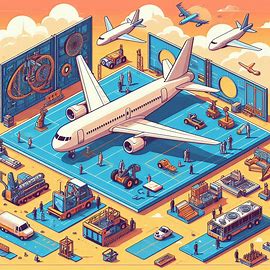
Introduction
Ever wondered how those massive commercial airplanes are constructed? Building a modern jetliner is a massive feat of engineering, requiring the coordination of thousands of workers, advanced technology, and global logistics. Aircraft manufacturing is among the most intricate and regulated industrial processes in the world, ensuring both performance and safety.
This comprehensive guide breaks down how commercial aircraft are built, step-by-step—from initial concept to delivery.
1. Conceptualization and Design Phase
1.1 Market Research and Planning
The process begins long before any physical materials are used. Aircraft manufacturers like Boeing and Airbus begin by identifying market needs:
- Is there demand for more fuel-efficient long-haul jets?
- Are regional routes underserved?
- What cabin configurations are airlines requesting?
These questions guide the launch of new aircraft projects.
1.2 Engineering and Digital Modeling
Once a concept is approved, aerospace engineers begin drafting the aircraft using advanced software like CATIA or Siemens NX.
Activities include:
- 3D modeling of aircraft structures and systems
- Simulations for aerodynamics, fuel flow, and stress
- Cost and feasibility analysis
This stage often takes several years and includes feedback loops from airlines, pilots, and safety regulators.
2. Materials and Component Manufacturing
2.1 Material Selection: Light and Strong
Modern aircraft are built with advanced materials to ensure strength without excessive weight:
- Aluminum alloys for fuselage and wings
- Carbon fiber composites for fuel efficiency (e.g., Boeing 787)
- Titanium for high-stress areas like engine mounts
Manufacturers must also consider corrosion resistance, ease of machining, and recyclability.
2.2 Parts Fabrication: Global Supply Chain
Aircraft parts are often manufactured across multiple continents.
Major Component Examples:
- Wings: Built in the UK (Airbus) or Japan (Boeing)
- Fuselage: Italy, Germany, and the U.S.
- Avionics: U.S., France, and other electronics hubs
This global approach lowers costs and taps into specialized expertise. The parts are shipped to final assembly locations using dedicated cargo aircraft like the Airbus Beluga or Boeing Dreamlifter.
3. Assembly and Integration
3.1 Final Assembly Line (FAL)
Final Assembly Lines are where components become a complete aircraft. Locations include:
- Toulouse, France (Airbus)
- Renton and Everett, Washington (Boeing)
Steps in Final Assembly:
- Join fuselage sections
- Attach wings and tail
- Install landing gear
- Connect flight control systems
This stage can take 1–3 months, depending on aircraft complexity.
3.2 System Integration and Electrical Work
After the structure is assembled, internal systems are installed and tested:
Systems include:
- Hydraulic and pneumatic systems
- Electrical wiring (over 300 miles in some aircraft)
- Avionics and cockpit instruments
Technicians perform continuous inspections to ensure everything meets stringent aviation standards.
4. Cabin Interior and Customization
4.1 Cabin Layout Installation
Airlines order custom configurations for their aircraft, including seating layouts, entertainment systems, and galleys.
Cabin Features:
- Economy, Premium Economy, Business, First Class
- Mood lighting, Wi-Fi systems, IFE (in-flight entertainment)
- Lavatories and crew rest areas
Each airline’s branding and service model influence how interiors are outfitted.
4.2 Quality Checks and Customer Approval
Before delivery, airlines inspect their aircraft for:
- Seat quality and finish
- Screen and control functionality
- Branding accuracy (logos, upholstery)
They may request adjustments before accepting delivery.
Table: Customization Options by Cabin Class
| Cabin Class | Custom Features |
|---|---|
| Economy | Seat pitch, screen size, lighting |
| Business | Lie-flat seats, privacy doors |
| First Class | Suites, showers, fine dining setups |
5. Testing, Certification, and Delivery
5.1 Ground and Flight Testing
Before a new aircraft is certified for commercial use, it must undergo rigorous testing:
Ground Tests:
- Hydraulic pressure
- Engine run-ups
- Electrical power checks
Flight Tests:
- Multiple test flights with sensors and telemetry
- Stall, climb, and glide tests
- Emergency procedure validation
All tests are supervised by authorities like the FAA or EASA.
5.2 Regulatory Certification and Handover
Each aircraft must receive a certificate of airworthiness from aviation regulators.
Once certified:
- Airlines send their crews for acceptance flights
- Paint and livery are completed
- The aircraft is officially handed over
Final delivery includes data packets, warranty documents, and optional pilot training support.
6. Innovations in Aircraft Manufacturing
6.1 Automation and Robotics
Many assembly tasks now use robotic assistance:
- Precision drilling of rivet holes
- Automated painting systems
- Robotic transport of large components
These technologies improve consistency and reduce error rates.
6.2 Sustainability and Eco-Efficiency
Manufacturers are adopting greener methods:
- Using renewable energy in plants
- Recycling materials like aluminum
- Reducing VOC emissions during painting
Example: Boeing’s 787 uses 50% composite materials to reduce fuel burn by 20–25% compared to older models.
6.3 3D Printing and Additive Manufacturing
3D printing is revolutionizing how small parts are made:
- Lightweight brackets and ducts
- Complex geometries that reduce part count
- Faster prototyping and revisions
Airbus and Boeing use additive manufacturing to reduce waste and speed up production.
Conclusion: Building the Future of Air Travel
Building a commercial aircraft is a marvel of global engineering, requiring advanced technology, skilled labor, and rigorous oversight. From concept to delivery, the process involves meticulous planning and constant innovation.
As we look toward the future, new materials, automation, and sustainability goals will continue to reshape how commercial aircraft are built.